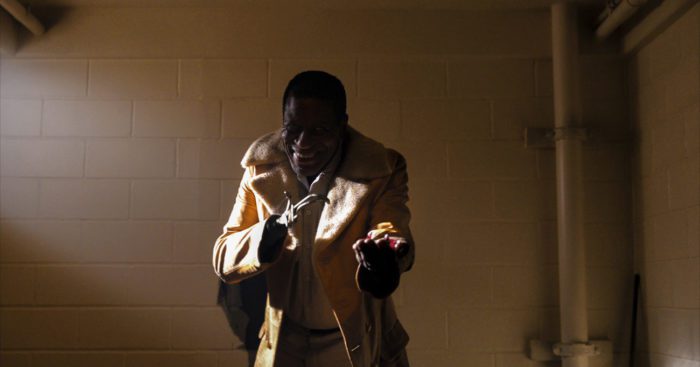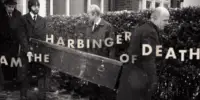I think I have to blurt this in order to get started: Nia DaCosta’s Candyman is one of the best new films I’ve seen this year. This is such a pristine and pertinent film that I feel frankly humbled to be writing about it. I should probably add that I feel somewhat privileged to be given such a clear view of a landscape other than any I’m used to, that of Black culture and the fears which attach to it. A white person myself, my usual privilege is one of relative comfort, so please bear with me as I navigate this. I hope it will be as worthwhile as the film itself.
There’s something else which has to be said: this is not a remake of the 1992 Candyman, written and directed by Bernard Rose. This 2021 film is self-contained and can be enjoyed by viewers who have or have not seen the earlier one. It is also a modernised view of the same fable, and at the same time, an extrapolation and a sequel to it. Writers Jordan Peele, Win Rosenfeld and Nia DaCosta have done a marvelous job of both standing on the shoulders of Rose’s earlier film and waving goodbye as they move forwards at the same time: a predecessor is worth acknowledging. I’m aware of Candyman fans who have worried that the Rose film would be dismissed or trampled on: this is most certainly not the case.

Candyman is set in Cabrini-Green, Chicago, largely in 2019, following a brief prologue set in 1977. In that earlier time, it had been a rough working class district (considered to be a “dangerous area” at the time of the first Candyman film), but it is now gentrified beyond recognition, housing sophisticated individuals such as artist Anthony McCoy (Yahya Abdul-Mateen II) and his partner Brianna Cartwright (Teyonah Parris). Through all these decades, tales have been told of a hook-handed man who will appear and kill when summoned. Nowadays, there are those who consider Cabrini-Green to be a haunted neighbourhood, while others dismiss the story as an urban legend. Anthony latches on to this local spectre as an image to revive his art, unwittingly reviving the spirit of the legend.
There you have it: not just the basis of the film’s plot, but the three central characters too: Anthony, the Candyman himself (whose face is hardly shown), and the location of Cabrini-Green. Anthony is largely self-absorbed at first, hardly considering the history or context of where he lives. He seems stunned by surprise when a critic comments that artists are the perfect residents of the redeveloped estate, living virtually for free over what used to be a ghetto. As the story progresses, Anthony often seems to be gripped in a bad dream, unable to shake it off and terrified of its hold on him. The expression of this terror through art reminded me of The Devil’s Candy at times—compulsive and vivid.

The Candyman, as shadowy and mysterious as he is, has to be considered a central character, too. In the first film, he was the spirit of Daniel Robitaille, a Black artist from the 19th century who had been lynched for falling for a white woman he had been painting. Disfigured, tortured with bees, and burned alive, Robitaille is said to return whenever someone speaks the name “Candyman” into a mirror and to release his pain onto the speaker. In DaCosta’s film, Candyman is not one person but instead represents racial violence that many people have been subjected to and which is “still happening,” as Anthony demonstrates in his installation entitled “Say My Name.” The Candyman is a very effective presence, whether he is there on the screen, hinted at or simply expected. His arrival is anticipated with a wrapped sweet or a couple of bees, and once he is summoned, there is blood. He rarely shows himself but allows his attacks to speak for themselves, instead.
And then there is the location. Through flashbacks, the audience is treated to a 1970s setting, a polar opposite to the sharp design and pristine interiors of the present day. The contemporary sights are simply adored by John Guleserian’s camera, though, which seems to pant at full-frontal doorways and shiny, long corridors. But, the present day Cabrini-Green still retains some buildings which have been forgotten instead of torn down, such as the chapel. As Antebellum reminded us recently (quoting William Faulkner), “The past is never dead. It’s not even past.”
There lies one of the themes of Candyman: the past cannot be denied. Just as some of the cast from 1992 feature here (such as Tony Todd and Vanessa Williams), Anthony can’t help but dig up pieces of local history and include them in his own story. There is something cyclical and inevitable about this, but that is not the case for the other key theme, that of race-related violence and injustice. It is stated that “these things happen and they are still happening,” but at no point is it suggested that there is anything particular to be done about it. I found it intriguing that although some of the examples cited were clearly white-on-black assaults, at no point did any of the dialogue come across as anti-white. Indeed, neither was there any particular call to action beyond the closing caption: “To learn more about resources and organizations that support racial justice and healing, please visit www.candymanmovie.com/impact.” Instead, the message is one of awareness and to “tell everyone.” The Candyman represents the continuation of violent injustice, and he wants the word passed on.

Oh, was it scary? I confess I had it easy, watching this press preview on a small screen. But yes, the tension, Anthony’s growing fear, the rhythmic score, and so much mutilation and dread: I have no doubt this is one scary film. The special effects, similar to The Invisible Man, are alternately striking and brutal, with beautiful effect made of both mirrors (of course) and the art gallery. Some of it, I warn you, is quite explicit, but not once was any injury exaggerated or dwelt on to a crude degree. There are shocks and surprises plenty (some quite satisfying) but no false jump scares. Trust me, there is nothing cheap about how Candyman effects its mood.
Candyman impressed me hugely. Some of the minor characters may have been there only to add a little extra colour, but other than that, nothing was wasted. Every image felt carefully chosen without being contrived, and every scene allowed me to understand Anthony and his world some more. I may not belong in Cabrini-Green, but I certainly feel like I’ve been there, and I’ll be going back again this weekend.


